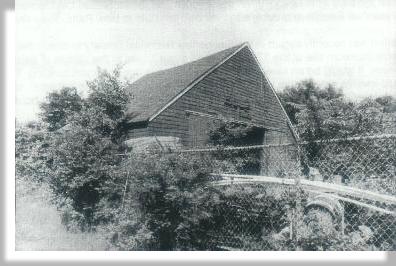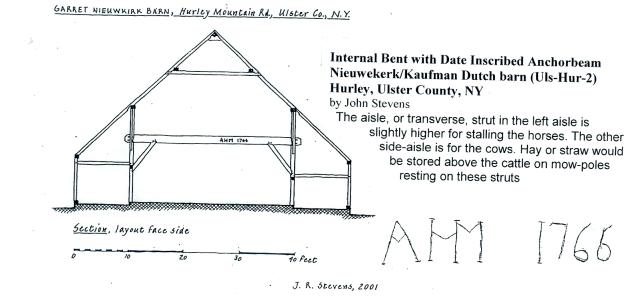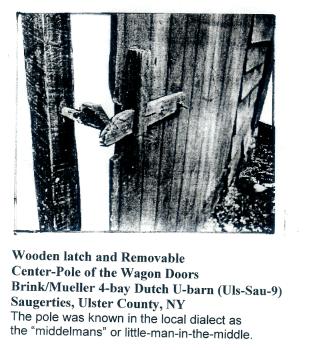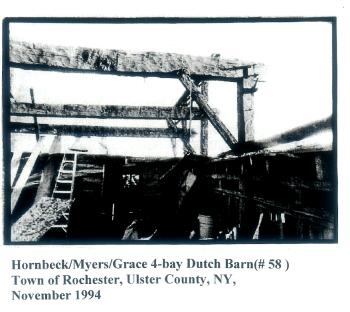Part One

Report
on
The Solite Dutch Barn
Saugerties, Ulster County NY
Its recent history,
a comparison with other barns
and plans for its future.
January 2004
by Peter Sinclair
The
following are edited and expanded reports from the HVVA Newsletter,
Volume 3, Number 6.
(Click
on all graphics for a larger view.)
Saturday,
August 18, 2001 nine people attended a short tour of two
barns in the Town of Saugerties, Ulster County. They were Jean Goldberg,
Alvin Sheffer, John and Marian Stevens, Hank Zigler, Jennie Marshall,
Alec Wade, Barry Benepe and myself. It was organized by the Saugerties
Historical Society and HVVA.
The first barn visited was the 3-bay Dutch barn on the Northeast Solite
property. I had learned about the barn from Greg Huber, some years
ago, when he had tried to interest the Huguenot Historical Society
in moving it to their museum site in New Paltz. They showed no interest.
An effort has recently begun in the Saugerties Historical Society
to obtain the building for its 1.5-acre museum site at the 1724 Kierstead
stone house in the Village of Saugerties, a few miles away. It would
be an ideal solution for preserving this important building, The project
would involve not only the work of moving and restoring the barn but
an archaeological and historical survey of the site that includes
the foundation of a house and a small intact stone building.
The
Solite 3-bay Dutch barn (Uls-Sau-19) is one of about 6 surviving
examples known in the Hudson Valley with a major/minor rafter system.
This rafter system was first identified in the Nieuwkerk/Kaufman
Dutch barn (Uls-Hur-2) in Hurley. Few barns have positive
dates of construction but the Nieuwkerk barn is inscribed "1766"
on an anchorbeam. In many ways, including the steep pitch of its roof,
the low height, 9feet, of its side walls and the spacing and number
of minor rafters, the Nieuwkerk barn seems to be the earliest of the
examples known and so it is estimated that The Solite Dutch Barn and
Carriage Barn the Solite barn was built circa 1770, December 2001,
photograph by John Stevens although the Solite barn includes some earlier
framing features such as lap-dovetail anchorbeam braces In 1963 John
Fitchen visited the Nieuwkerk barn and numbered it "42"
in his registration of 76 Dutch barns. He noted the gouge-cut marriage
marks on timbers but the barn was full of hay and unfortunately Fitchen
did not get to see the rafter system and he remained unaware of this
Dutch barn feature. In Greg Huber's second edition (page 189) of Fitchen's
book, The New World Dutch Barn, he refers to the Nieuwkerk
barn as one of three Dutch barns in Ulster County with major/minor
rafter systems extant. There are probably a total of 100 Dutch barns
extant in the county. "Seventeen other barns in Ulster County,"
Huber writes, "have evidence to varying degrees of this pre-war
barn type." In other writing Huber refers to the possibility
of this rafter system's use in Bergen County, New Jersey.
The rafter system of the Solite barn is not a New World tradition
but the survival of a European, and I believe Dutch tradition with
Medieval origins. We have very few examples of pre Revolutionary barns.
Most of our experience is with the 19th century or late 18th century
examples almost all with common rafters but these early major/minor
rafter system barns suggest that Hudson Valley architecture of the
17th and early 18th century may have had more Old World features than
we are aware of today.

The
last barn visited was
 The Brink/Mueller 4-bay Dutch U-barn
The Brink/Mueller 4-bay Dutch U-barn
(Uls-Sau-9). This is a small sized barn with a 20-foot nave
(the Solite barn is a medium sized barn with a 25-foot nave). The
barn was built soon after 1805, the date Corenelius Brink bought the
land. The Brink and Winne families were the first to settle the Saugerties
area in the late 17th century. Built as a U-barn with lowered anchorbeams
in two bents that formed a wide end bay, it was later converted to
a true-form drive-through Dutch barn by cutting through the lowered
beams and adding wagon doors on the end wall. The barn has a lowered
side aisle used as a horse stall. As in the Solite barn there is evidence
of built in stake hay mangers for the horses. The stall in the Brink
barn seems low for the manger but the floor is presently dirt. Originally
it may have been higher with a plank floor resting on sleepers.
The oak frame of the Solite barn is in generally good condition. A
good roof and recent repairs to one wall plate and replacement of
several rafters has stabilized and saved the structure. It no longer
has a threshing floor and not much of its sills survive. The Brink
barn has a wood pegged threshing floor in good condition and many
original features, like the latching system for the wagon doors, that
could help in the restoration of the Solite barn. In both barns the
longitudinal struts on the cow side have been removed.
Saturday,
August 25,2001
 I spent the day at the Hornbeck/Myers/Grace farm (# 58) Town
of Rochester, Ulster County, NY.
I spent the day at the Hornbeck/Myers/Grace farm (# 58) Town
of Rochester, Ulster County, NY.
Worked with Robert Stevens, son-in-law of the present owner
of this third generation Grace family farm, and with a tenant, removing
and examining timber from the collapsed frame of this 5-bay Dutch
barn with the identical "AHM 1766" inscription as in the
Nieuwkerk barn in H. The two barns were probably erected by the same
builder in the same year. The Hornbeck barn was altered in the 19th
century by raising the side walls and its major/minor rafter system
replaced with common rafters. Three of the six 30-foot anchorbeams
survive including the inscription beam. Some of the frame has already
been removed by Robert Stevens and is in safekeeping in the 30x40-foot
circa 1870 side-entrance barn that has an end wall in need of repair.
Two longitudinal struts from the left horse-side of the Hornbeck barn
survive with notching for a hay manger and struts from the cow side
survive with a series of holes drilled vertically to form a stake
wall.
The Hornbeck farm was visited by Hellen Wilkinson Reynolds who described
the house and its history in her classic 1929 book, Dutch Houses of
the Hudson Valley before the Revolution, (see page 207). She noted
the inscribed "AHM 1776" date in the barn and speculated
that it might also be close to the date of the Dutch stone house on
the farmstead.
At the Grace farmstead, we also jacked and placed blocks under the
wheels of a box wagon with wooden spooked wheels and two independent
sets of wheels that were sinking into the moist mud floor of the cellar
of the granary. The wheels seem in good condition. Wagons and barns
were made for each other and both are endangered in the Hudson Valley.
I returned to the Hornbeck barn a week later with Bob Hedges to estimate
repairs to the side entrance barn and we moved a few more parts. I
acquired a 2-foot section of a notched manger strut for a future museum.
Disassembly
of The Solite Barn.
(upper
left) Bob Hedges and crew disassemble the Solite carriage barn, April
2002 (upper right and lower right) Jim Kricker and crew remove the
ridge pole, December 2003 (lower left) Upper purlins and rafters removed,
December 2003
The
removal of the light and delicate 45-foot long 4-sided ridge pole
and two upper purlins was a unique situation that required good planning
and teamwork.
Part
Two